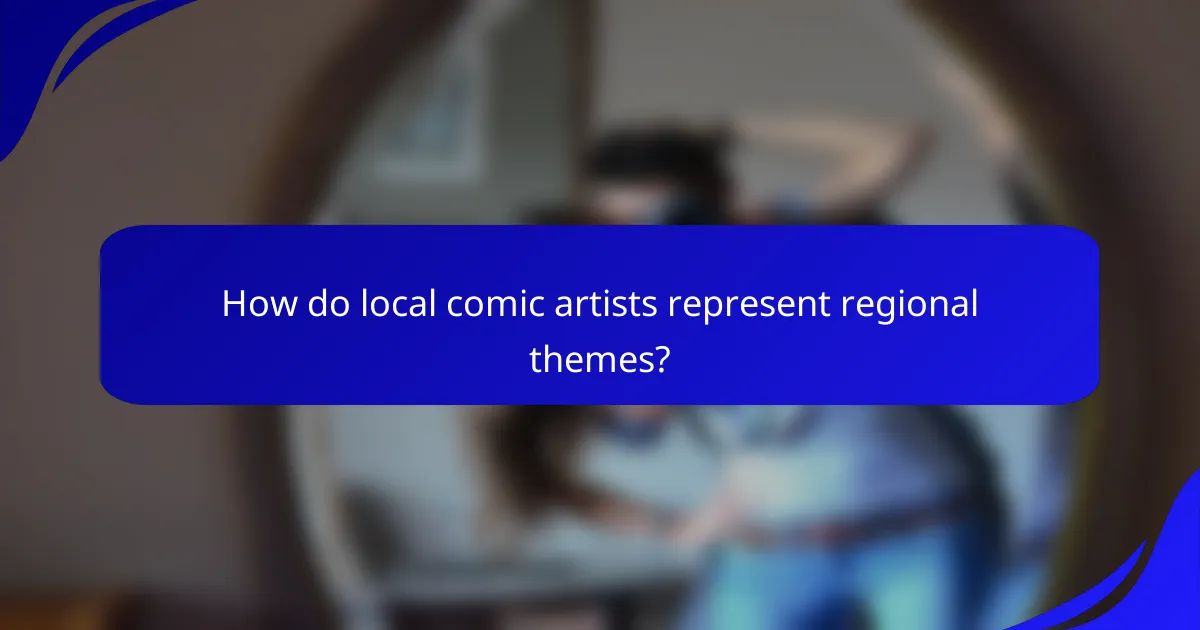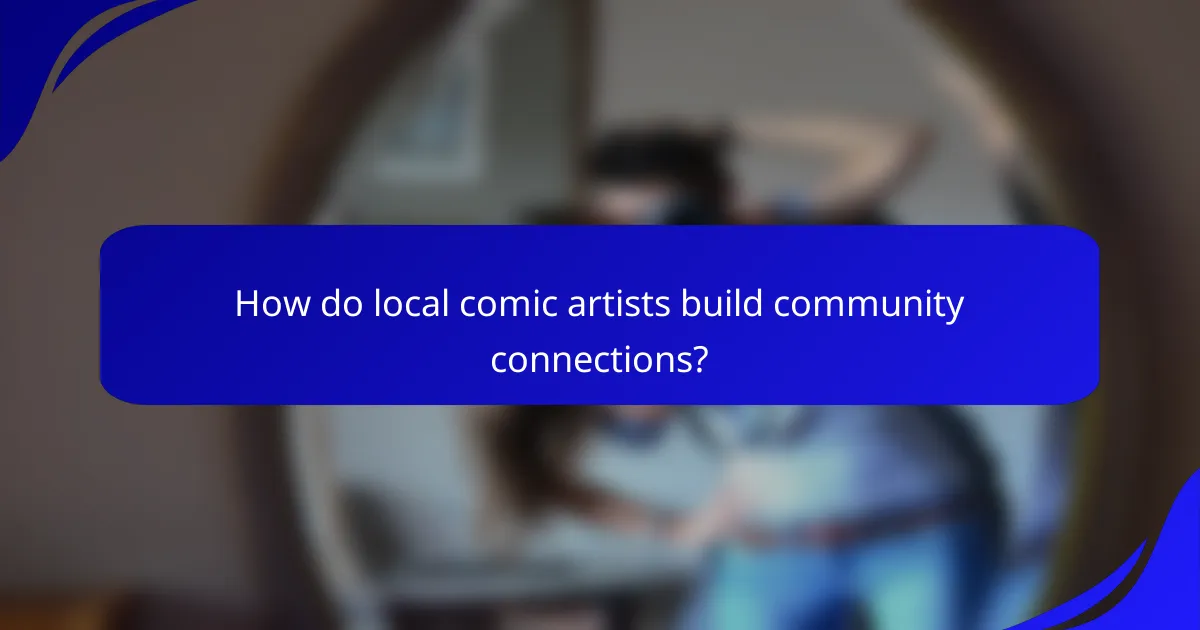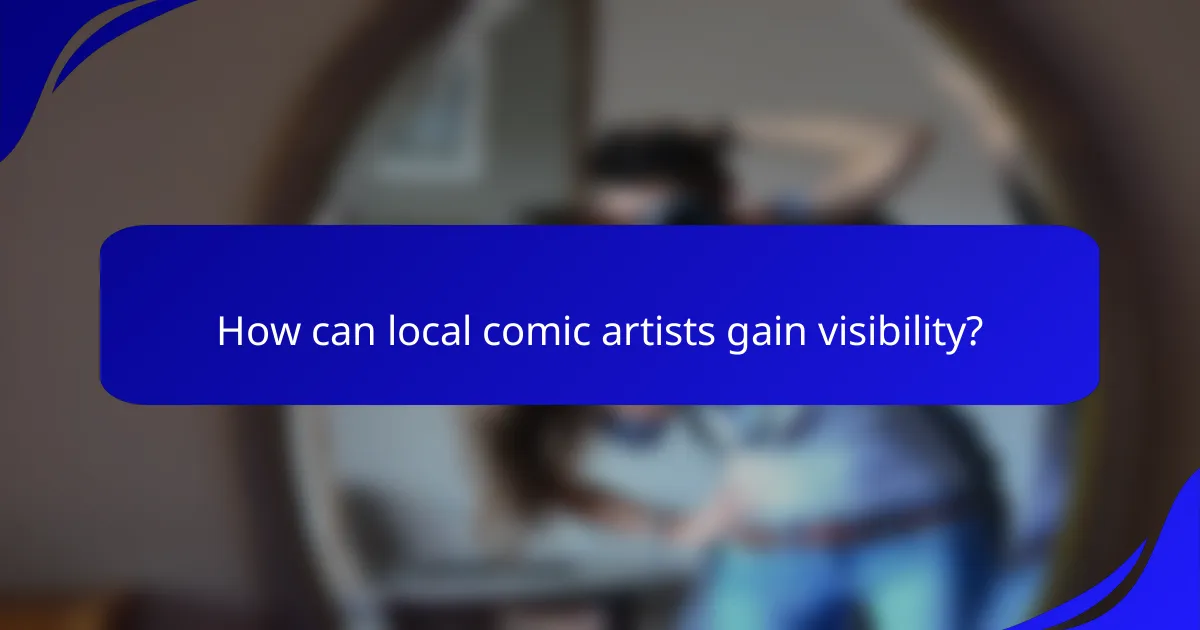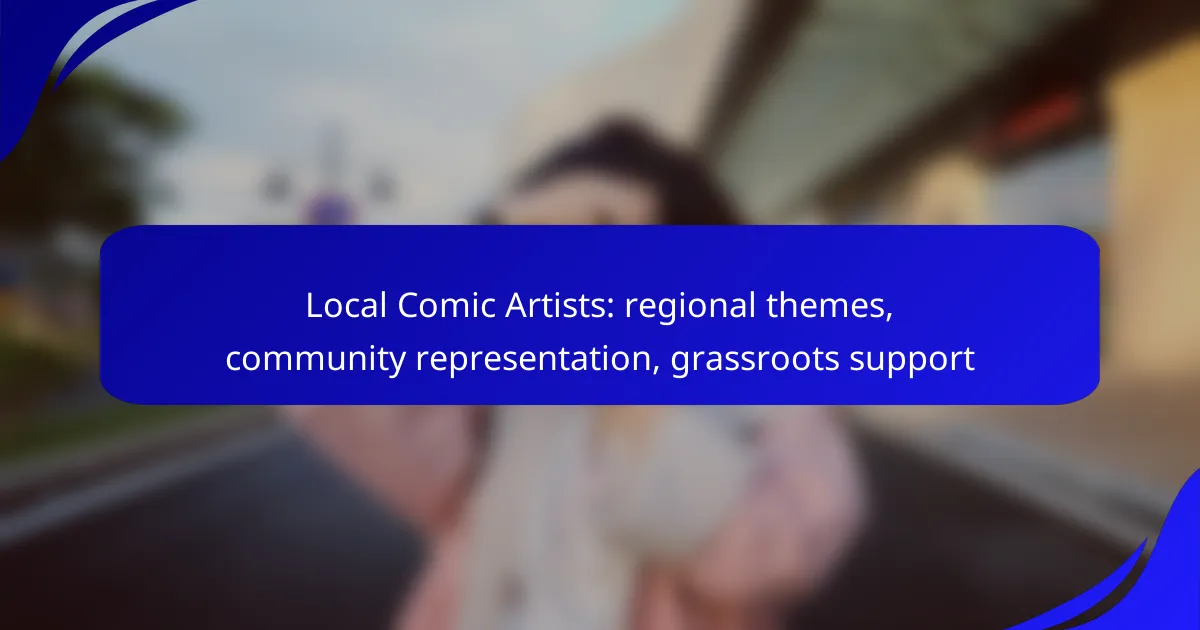Local comic artists play a vital role in reflecting the unique themes and stories of their communities, using storytelling and visual styles that resonate with regional audiences. Through grassroots support and community initiatives, these artists gain visibility and opportunities to thrive, fostering collaboration and connection within their creative landscapes.

How do local comic artists represent regional themes?
Local comic artists often reflect regional themes by incorporating elements that resonate with their communities. This representation can manifest through storytelling, visual styles, and cultural references that are unique to specific locales.
Incorporation of local folklore
Local comic artists frequently draw inspiration from regional folklore, weaving traditional tales and myths into their narratives. This approach not only preserves cultural heritage but also makes the stories relatable to local audiences.
For example, artists in Eastern Europe might include Slavic myths, while those in the American South may feature local legends like the Mothman. These stories often serve as a backdrop for character development and plot progression.
Depiction of community events
Community events are a rich source of inspiration for local comic artists. By illustrating festivals, parades, and local gatherings, they capture the spirit and vibrancy of their neighborhoods.
These depictions can foster a sense of belonging and pride among residents, as they see their own experiences reflected in the artwork. Artists may choose to highlight annual events like harvest festivals or cultural celebrations, making them central to their stories.
Use of local dialects and languages
Incorporating local dialects and languages adds authenticity to comic narratives. This practice allows characters to speak in ways that resonate with the community, enhancing relatability and immersion.
For instance, a comic set in Scotland might feature Scots Gaelic phrases, while a comic from New York City might include elements of Spanglish. This linguistic diversity enriches the storytelling and connects readers to their cultural roots.
Highlighting regional issues
Local comic artists often address regional issues, such as economic challenges, environmental concerns, or social justice topics. By tackling these subjects, they raise awareness and encourage dialogue within their communities.
For example, comics may explore the impact of urban development on local neighborhoods or highlight the struggles of small businesses. This engagement can inspire activism and community involvement among readers.
Showcasing local landmarks
Local landmarks serve as significant backdrops in comics, grounding stories in recognizable settings. Artists often depict famous buildings, parks, or natural features that resonate with local readers.
For instance, a comic set in Paris might feature the Eiffel Tower, while one from Chicago could showcase the Willis Tower. These landmarks not only enhance the visual appeal but also evoke a sense of place and identity for the audience.

What grassroots support exists for local comic artists?
Grassroots support for local comic artists includes community-driven initiatives that foster creativity, collaboration, and visibility. This support often manifests through events, conventions, partnerships, and funding opportunities that empower artists to thrive within their regions.
Community art events
Community art events serve as vital platforms for local comic artists to showcase their work and connect with audiences. These gatherings can include art fairs, workshops, and exhibitions that highlight regional themes and narratives. Participating in these events allows artists to gain exposure and engage with their local fan base.
Examples of such events might include monthly art walks or seasonal festivals, where artists can set up booths and interact directly with attendees. These opportunities often encourage collaboration among artists and help build a supportive network.
Local comic conventions
Local comic conventions provide an essential venue for comic artists to display their creations and network with other creators and fans. These conventions typically feature artist alleys where local talent can sell their work, participate in panels, and engage in discussions about the comic industry.
Attending or exhibiting at these conventions can significantly enhance an artist’s visibility and allow them to connect with potential collaborators and customers. Many conventions also offer workshops that can help artists improve their craft and business skills.
Collaborations with local businesses
Collaborations with local businesses can create mutually beneficial relationships that promote comic artists while supporting the community. For instance, comic shops, cafes, or bookstores may host artist signings or exhibit local artwork, providing artists with a platform to reach new audiences.
Such partnerships can also lead to unique projects, like limited edition prints or merchandise that feature local themes. Artists should actively seek out businesses that align with their vision and propose collaborative ideas that can attract customers for both parties.
Funding from regional grants
Funding from regional grants is a crucial resource for local comic artists looking to finance their projects. Many local governments and arts organizations offer grants specifically aimed at supporting creative endeavors, including comic art. These grants can cover production costs, marketing, and even living expenses while artists work on their projects.
Artists should research available grants in their area, paying attention to application deadlines and eligibility criteria. Preparing a strong proposal that outlines the project’s goals, community impact, and budget can significantly increase the chances of securing funding.

How do local comic artists build community connections?
Local comic artists build community connections by actively engaging with their audience and collaborating with fellow creators. These efforts foster a sense of belonging and representation within their regional contexts.
Engagement through social media
Social media platforms are vital for local comic artists to connect with their communities. They can share their work, promote events, and interact with fans, creating a dialogue that strengthens relationships. Artists often use platforms like Instagram and Twitter to showcase their art and receive immediate feedback.
For effective engagement, artists should post regularly and use relevant hashtags to reach a broader audience. They can also participate in online challenges or collaborations to increase visibility and community interaction.
Participation in local workshops
Local workshops provide comic artists with opportunities to hone their skills while connecting with peers and aspiring creators. These events often focus on specific techniques, storytelling methods, or industry insights, allowing artists to learn and share knowledge in a supportive environment.
Artists interested in workshops should seek out community centers, libraries, or local art organizations that host such events. Participating in these workshops can lead to valuable networking opportunities and potential collaborations.
Networking with other artists
Networking with other artists is crucial for local comic creators to build a supportive community. By attending conventions, art fairs, or local meetups, artists can share experiences, exchange ideas, and collaborate on projects. This camaraderie can lead to joint ventures that amplify their reach.
To maximize networking opportunities, artists should prepare a portfolio and be open to discussing their work with others. Establishing genuine connections can lead to mentorship opportunities and increased visibility within the local comic scene.

What are the challenges faced by local comic artists?
Local comic artists encounter several challenges that can hinder their success, including limited funding, competition from larger publishers, and difficulties in accessing distribution channels. These obstacles can restrict their ability to create and share their work effectively.
Limited funding opportunities
Local comic artists often struggle to secure funding for their projects, which can limit their creative output. Many rely on personal savings, crowdfunding, or small grants, but these sources may not cover all production costs.
To navigate this challenge, artists can explore local arts grants, community sponsorships, or crowdfunding platforms tailored for creative projects. Engaging with local businesses for sponsorship can also provide financial support while fostering community ties.
Competition from mainstream publishers
Local comic artists face stiff competition from mainstream publishers who have larger marketing budgets and established distribution networks. This can make it difficult for independent creators to gain visibility and attract a dedicated audience.
To stand out, local artists should focus on unique storytelling that reflects regional themes or community issues. Building a strong online presence through social media and participating in local comic conventions can also help them connect with potential readers and fans.
Access to distribution channels
Accessing distribution channels is a significant hurdle for local comic artists, as many traditional outlets prioritize established publishers. This can limit the reach of their work, making it harder to sell physical copies or gain readership.
Artists can consider alternative distribution methods such as online sales through platforms like Etsy or their own websites. Collaborating with local bookstores or comic shops for consignment deals can also enhance visibility and sales opportunities.

How can local comic artists gain visibility?
Local comic artists can gain visibility by leveraging various platforms and strategies that connect them with their audience and community. Focusing on grassroots support, online presence, and funding opportunities can significantly enhance their reach and recognition.
Utilizing crowdfunding platforms
Crowdfunding platforms like Kickstarter and Indiegogo provide local comic artists with a way to fund their projects while building a community around their work. Artists can set funding goals and offer rewards to backers, which encourages engagement and investment in their creative vision.
When using crowdfunding, it’s crucial to create a compelling pitch that highlights the unique aspects of the comic. Including visuals, a clear budget breakdown, and a timeline can help potential backers understand the project’s value. Successful campaigns often raise anywhere from a few hundred to several thousand dollars, depending on the artist’s network and marketing efforts.
Creating online portfolios
Building an online portfolio is essential for local comic artists to showcase their work and attract potential readers or collaborators. Websites like Behance, ArtStation, or personal domains allow artists to display their comics, illustrations, and other related projects in a professional manner.
To maximize visibility, artists should regularly update their portfolios with new content and share their work on social media platforms like Instagram and Twitter. Engaging with followers and participating in relevant online communities can further enhance their presence. A well-curated portfolio can lead to opportunities such as commissions, collaborations, or even publishing deals.
